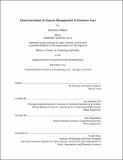| dc.contributor.advisor | Leo Anthony Celi and Stan Finkelstein. | en_US |
| dc.contributor.author | Baker, Lawrence | en_US |
| dc.contributor.other | Massachusetts Institute of Technology. Institute for Data, Systems, and Society. | en_US |
| dc.contributor.other | Technology and Policy Program. | en_US |
| dc.date.accessioned | 2020-04-13T18:24:32Z | |
| dc.date.available | 2020-04-13T18:24:32Z | |
| dc.date.copyright | 2019 | en_US |
| dc.date.issued | 2019 | en_US |
| dc.identifier.uri | https://hdl.handle.net/1721.1/124577 | |
| dc.description | This electronic version was submitted by the student author. The certified thesis is available in the Institute Archives and Special Collections. | en_US |
| dc.description | Thesis: S.M. in Technology and Policy, Massachusetts Institute of Technology, School of Engineering, Institute for Data, Systems, and Society, 2019 | en_US |
| dc.description | Cataloged from student-submitted PDF version of thesis. | en_US |
| dc.description | Includes bibliographical references (pages 121-130). | en_US |
| dc.description.abstract | Patients in intensive care routinely have their blood glucose monitored and controlled using insulin. Two decades of on-going research has attempted to establish optimal glucose targets and treatment policy for patients with hyperglycemia in the intensive care unit (ICU). These efforts rely on the assumption that health care providers can reliably meet given targets. Significant proportions of the ICU population are either hypoglycemic or hyperglycemic and poor blood glucose control may lead to adverse patient outcomes. This thesis analyses approximately 20,000 ICU stays at the Beth Israel Deaconess Medical Center (BIDMC) which occurred between 2008 and 2018. These data are used to describe the state of clinical practice in the ICU and identify areas where treatment may be suboptimal. Even at a world-renowned teaching hospital, blood sugars are not optimally managed. 41.8% of diabetics and 14.2% of non-diabetics are severely hyperglycemic (>215mg/dL) each day. Insulin boluses are given more frequently than insulin infusions, despite guidelines recommending infusions for most critical care patients. When infusions are given, rates do not follow a consistent set of rules. Blood sugar management faces several challenges, including unreliable readings. Laboratory and fingerstick measurements that were taken at the same time had an R² of only 0.63 and the fingerstick measurements read on average 10mg/dL higher. Overcoming these challenges is an important part of improving care in the ICU. It is hoped that publicly sharing the code used to extract and clean data used for analysis will encourage further research. Code can be found at https://github.com/lawbaker/MIMIC-Glucose-Management | en_US |
| dc.description.statementofresponsibility | by Lawrence Baker. | en_US |
| dc.format.extent | 130 pages | en_US |
| dc.language.iso | eng | en_US |
| dc.publisher | Massachusetts Institute of Technology | en_US |
| dc.rights | MIT theses are protected by copyright. They may be viewed, downloaded, or printed from this source but further reproduction or distribution in any format is prohibited without written permission. | en_US |
| dc.rights.uri | http://dspace.mit.edu/handle/1721.1/7582 | en_US |
| dc.subject | Institute for Data, Systems, and Society. | en_US |
| dc.subject | Technology and Policy Program. | en_US |
| dc.title | Characterisation of glucose management in intensive care | en_US |
| dc.type | Thesis | en_US |
| dc.description.degree | S.M. in Technology and Policy | en_US |
| dc.contributor.department | Massachusetts Institute of Technology. Institute for Data, Systems, and Society | en_US |
| dc.contributor.department | Massachusetts Institute of Technology. Engineering Systems Division | |
| dc.contributor.department | Technology and Policy Program | en_US |
| dc.identifier.oclc | 1149091156 | en_US |
| dc.description.collection | S.M.inTechnologyandPolicy Massachusetts Institute of Technology, School of Engineering, Institute for Data, Systems, and Society | en_US |
| dspace.imported | 2020-04-13T18:24:03Z | en_US |
| mit.thesis.degree | Master | en_US |
| mit.thesis.department | ESD | en_US |
| mit.thesis.department | IDSS | en_US |
